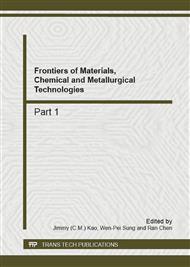p.138
p.142
p.146
p.150
p.154
p.160
p.164
p.168
p.172
Study on “Vacuum Migration” of the Desorption of Ethanol-Loaded Activated Carbon by Microwave Irradiation
Abstract:
The utilized ethanol in waste water from ethanol industry may be recovered through activated carbon adsorption and microwave desorption of the ethanol-loaded activated carbon. The flow charts for microwave desorption of ethanol-loaded activated carbon under N2 condition and vacuum condition are designed respectively. The institute parts of the desorbed vapors change when the tests are taken under vacuum condition and the system pressure affects the separation effect obviously. The quantity of ethanol in the vapors will increase when the system pressure is reduced, and this law is still right in the case of taking microwave as the heat source. The experimental results show that the ethanol-loaded activated carbon can be desorbed nearly completely after 100s when the microwave power is not weaker than 320W. After three processes of activated carbon adsorption and microwave desorption under vacuum condition, the concentration of ethanol can come up to over than 97%~98% from 4%~8%. The separation effect of microwave desorption can be enhanced when it is combined with the method of vacuum desorption. This law will be significant for the treatment of wastewater containing organic matter from industry using microwave desorption technology.
Info:
Periodical:
Pages:
154-159
Citation:
Online since:
October 2012
Authors:
Keywords:
Price:
Сopyright:
© 2012 Trans Tech Publications Ltd. All Rights Reserved
Share:
Citation:


